RMS Queen Mary
The RMS Queen Mary is a British liner, currently retired, that served mainly on the Atlantic crossing between 1936 and 1967 for the Cunard Line shipping company. She built by the Scottish shipyards of John Brown & Company, was designed to be the first of two ships that Cunard had planned for express service on the route between Southampton and New York, in response to the large European vessels of the late 1920s and early 1930s. She was the company's flagship from May 1936 until March 1940, when her sister ship, RMS Queen Elizabeth, entered service.
The Queen Mary made its maiden voyage on May 27, 1936 and in August of that year it won the coveted "Blue Ribbon", which awarded the ship that completed the fastest transoceanic route. In 1937, she lost that title to the French ship SS Normandie, although she managed to recapture it in 1938, holding it until 1952, when her speed record was surpassed by the SS United States.
Both the Queen Mary and the Queen Elizabeth were converted and used to transport troops during World War II. Their high speeds allowed them to escape the German submarines, causing Hitler to even offer rewards for the sinking of both ships.
After the war, the Queen Mary was refitted for her return to civil service and, together with the Queen Elizabeth, they dominated the Atlantic passenger service market, for which they had initially been conceived, until the growing rise of Jet aircraft, at the end of the 1950s, marked the decline of maritime transport. By the middle of the next decade, the Queen Mary had aged noticeably and, although she was still one of the most popular liners, she was operating at a loss.
After several years of gradual decline in revenue, Cunard withdrew the ship from service in 1967, leaving the port of Southampton for the last time on October 31 of that year, sailing to Long Beach, California, where it remains today. permanently anchored to the docks. Most of the machinery, including one of the two engine rooms, three of the four propellers and all of the boilers, were removed. It currently functions as a tourist attraction, housing a museum, a hotel and restaurants.
The Queen Mary is listed on the National Register of Historic Places in the United States, and has also been listed by the National Association for Historic Preservation as one of the country's historic hotels.
Construction and design
Construction
The new German liners Bremen and Europa were introduced into transoceanic service in the late 1920s, and the United Kingdom did not want to be left behind in the face of new competition. Not to be left behind, the White Star Line began, in 1928, the construction of a large 300 m long liner, the RMMV Oceanic. The Cunard Line also began planning a new ship of similar size, 310 m and 81,000 tons of displacement.
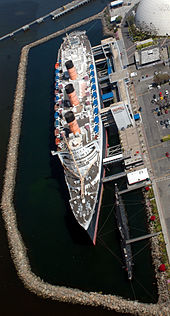
The construction of said ship, then known only by the number 534, was announced in April 1929 and its keel was laid a year later, the December 1, 1930, at the John Brown & Company, located in Clydebank (Scotland), on the banks of the River Clyde. The launching was planned for May 1932. But the work was paralyzed at the end of 1931, due to the economic damage derived from the Great Depression, which affected all shipping companies; Therefore, Cunard requested a loan from the British government to complete the ship. Credit was granted, providing £9,500,000, enough money for the completion of hull 534 and to build a sister ship, hull no. 552, which would become the Queen Elizabeth.
One of the conditions of the credit was that Cunard merge with its main rival, the White Star Line, which had been forced to abandon the construction of the Oceanic due to the economic situation at the time. Both shipping companies accepted and the merger was completed on May 10, 1934. Work resumed in April 1934, the hull was completed in August and on May 26 September 1934, the Queen Mary was finally launched. Her construction had taken three and a half years, at a cost of £3,500,000. Most of the interiors were designed and built by Bromsgrove Guild.
The ship was completed in March 1936, carrying out the first sea trials between the River Clyde (near Glasgow) and Arran, There she was taken to Southampton where she docked to complete the finishes and was delivered to Cunard White Star on 11 May of that year.
The ship was named in honor of Queen Queen Mary, consort of George V of the United Kingdom, who attended the launching ceremony in 1934. Until Upon release, the name was kept secret. A fairly widespread legend stated that the company intended to name the ship Queen Victoria, thus maintaining Cunard's tradition of using the suffix "-ia" in the names of their ships, but when the company representatives asked the king for permission to name the ship in honor of the "best queen" of Great Britain, he responded that his wife would be delighted. So, according to legend, the delegation had no choice but to name the ship Queen Mary.
This story, however, was denied by official company sources. Traditionally, only sovereign names had been used for Royal Navy flagships. Some support for the legend came from Washington Post editor Felix Morley, who sailed as a guest of the Cunard White Star Line on the Queen Mary's maiden voyage in 1936. In his autobiography For the Record, published in 1979, Morley wrote that during the voyage he shared a table with the president of the shipping company, Sir Percy Bates, who told him the story "on the condition that he not divulge it in writing" as long as he lived. The name could also have arisen as an agreement between Cunard and White Star, since they used their own suffixes to name their ships, the ending "-ic" It was used by the White Star Line and "-ia" the Cunard Line.
The name was already used by the steamship TS Queen Mary, so Cunard White Star reached an agreement with its owners to rename it Queen Mary II.

Design
The Queen Mary had a length of 310.7 m and a beam of 36.12 m. It displaced a total of 100,000 gross register tons, and was powered by 16 steam turbines that generated 160,000 CV on its four axles, which gave it a speed of 30 knots. The ship had 776 first class cabins, 784 cabin class and 579 tourist class.
During the first year of its career, the ship turned out to be criticized for its exterior design, since it was very traditional compared to its French rival, the SS Normandie, since it had a bow that exhibited rounded lines and very modern. Everything except her stern gave the Queen Mary the appearance of a larger version of her predecessor ships. However, despite these criticisms, she proved to be more popular than the Normandie.
The ship was painted with the exterior colors always used by the Cunard Line.

Interior
Its interior design was mostly Art Deco style, which made it look more conservative and sober unlike its French rival. Many of the interior spaces were designed and built by the Bromsgrove Guild company.
The Queen Mary had three classes for passenger accommodation, first class, cabin class and tourist class. The services on board varied depending on the class where she was traveling. First class offered the most space and luxury. Among the services available on board, there were two indoor swimming pools (one for first class and one for cabin class), a beauty salon, a library, a children's play area, four outdoor paddle tennis courts, a dance hall, restaurants, synagogue, elevators, kennels and galleries, among other facilities. The largest room was the first-class dining room (also known as the Grand Salon), which spanned three decks in height. The first-class pool facilities were also more than two decks high.
In the first class dining room there was a large map showing the crossing of the Atlantic, with two routes on it, one symbolizing the route during the winter/spring (further south to avoid icebergs) and the one used during the summer/autumn period. During the voyages, a motorized scale model of the Queen Mary indicated the ship's progress along the route.
History
Maiden voyage and early years
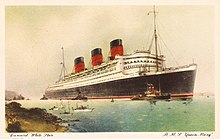
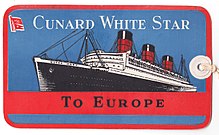
The first test voyage was scheduled for May 14, 1936 and then its maiden voyage, covering the route between Southampton and New York, was scheduled for May 27. On this voyage, he was commanded by Captain Sir Edgar T. Britten, sailing at high speeds for most of his first voyage to the United States, until, on the last day of the route, bad weather forced him to reduce its speed, which prevented it from breaking the record previously set by the Normandie, despite what was believed at the time.
After returning from New York, the Queen Mary remained in dry dock during the month of July to undergo modifications, in which its turbines were readjusted, as well as the shafts of its four propellers. Upon returning to regular service in the Atlantic, the ship managed to surpass the speed record and snatch the Blue Band from its French rival with an average speed of 30.99 knots (57.39 km/h) towards North America and 31.69 knots heading to Great Britain.
In May 1937, after only one year in service, the Queen Mary had carried a total of 56,895 passengers. In August 1938, she managed to recapture the Blue Band, which had recaptured the Normandie during the previous year. After winning the award for the second time, the ship established a new speed record on the east and west transoceanic routes, allowing it to retain the distinction of the fastest ship in the world, until the SS United States entered service in 1952.
World War II


On August 30, 1939, with the outbreak of World War II, the ship made its last commercial voyage, setting sail from Southampton to New York, transporting $44 million in gold bullion and 2,552 passengers, including which included actor Bob Hope and his wife, Dolores Hope. The ship remained moored in the New York port until the end of the year, while the role she would play during the conflict was decided.
On March 7, 1940, she joined her recently completed sister ship, the RMS Queen Elizabeth, in company with the second Mauretania and the Normandie, which docked in New York to begin carrying out her duties. military functions. On March 21, 1941, the Queen Mary set sail for Cape Town and Sydney where conversion work would be carried out to transform it into a troop transport ship. The luxurious decorations were removed and in their place bunk beds were installed to accommodate the soldiers. Small-caliber artillery pieces were also installed, relying on their speed as the main defense weapon.
Its first mission as a troop transport took place on May 4 of that year, when it transported 5,000 Australian troops to Clyde and from there it sailed to Singapore on June 16. After undergoing a routine check-up, she spent the rest of the year transporting troops between Sydney and India. The ship went into dry dock in February 1941 and then continued to transport troops between Singapore and Suez until November of that year. Because the waters were becoming very dangerous due to the Japanese threat in the Pacific and the Middle East, she was sent to Boston to begin operations in the Atlantic. Once again it went into dry dock, its capacity was increased to 8,500 troops and its artillery capacity was repowered with larger caliber weapons and a greater number of anti-aircraft. However, plans were changed and she was again sent to Australia.
In July 1942 he returned to New York and in the following months he was taken to Clyde and Suez, returning with a contingent of German prisoners. After being equipped with new modifications, on August 2 of that same year, he began transporting between 10,000 and 15,000 men per voyage.
Incident with the HMS Curacoa
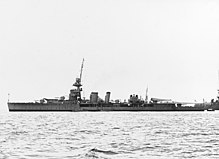
On October 2, 1942, approaching the River Clyde, the Queen Mary required escort, a mission that was entrusted to the anti-aircraft cruiser HMS Curacoa, in the company of 6 destroyers. The Queen Mary was sailing at 28 knots in a zig-zag pattern as an anti-submarine measure, closely escorted by the Curacoa, which was sailing in a straight line and at only 26 knots. When the liner passed it, both courses coincided at some point, leading to a inevitable collision. The Queen Mary's bow struck the Curacoa's stern near the mizzenmast and tore a deep hole that flooded the engine room, splitting her in two and she quickly sank. Of the cruiser's 430 crew, only 101 of her could be rescued.However, the Queen Mary, with damage to her bow below the waterline, was able to continue her journey to Clyde, reducing her speed to 10 knots. A legal battle broke out between the Cunard White Star and the Admiralty, ending in a draw. upon establishing that there was shared responsibility between the captains of both ships.
End of the war
From October to December 1942, the ship remained in Boston for repairs and then returned to Clyde. On 23 December she sailed for Cape Town, Suez and Sydney transporting British troops to the Middle East and Australian troops home. She returned to American waters in April 1943, docking in New York Harbor in May. From then on, her mission was to transport American troops during the remainder of the conflict, especially moving divisions from Europe to the Pacific. At the end of December 1942, being 1,126 km from Scotland and carrying 11,339 passengers and crew, a giant wave 28 m high hit the Queen Mary, causing the ship to list briefly up to 52°.
Once the war was over, he continued to repatriate American soldiers, along with their girlfriends and new wives, back to their country until May 3, 1946, when he was transferred to the route between the United Kingdom and Halifax to lead the families. of Canadian soldiers returning home, a mission that extended until September of that same year.
Finally, on September 27, the Queen Mary was returned to the Cunard White Star Line, having traveled 600,000 miles and transported more than 800,000 people during the war.
Later career
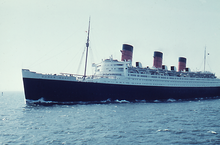
After being returned to her owners, the Queen Mary was taken to Southampton, where she was rehabilitated and re-equipped again as a liner. During the restoration work, new turbines were installed and the navigation and air conditioning systems were replaced. Passenger capacity was modified to accommodate a total of 711 people in first class and 1,284 in economy class. The first commercial voyage after World War II took place on July 31, 1947, covering the original route between Southampton and New York. However, before the end of the year, the ship was involved in a new incident, when she ran aground near Cherbourg (France).
In December 1949, Cunard White Star was dissolved and became the Cunard Line again, since the latter had acquired 38% of the company that belonged to the White Star Line, definitively absorbing said company.
Throughout the 1950s, the Queen Mary and her twin, the Queen Elizabeth, became an important source of income for Cunard, which managed to position itself in a very good position in the Atlético route. In 1952, new competition began to emerge, when the new American liner SS United States took the Blue Band after surpassing the speed record of the Queen Mary, crossing the Atlantic at a speed of 35.59 knots (65.9 km /h), being 4.6 knots (8.51 km/h) faster than the Cunard ship.
Last years in service
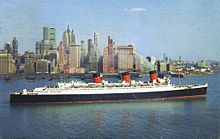
At the end of the 1950s, new financial problems began to affect the company's operations, as a consequence of the increasingly growing air transport.
During 1958, the Queen Mary was drydocked for routine maintenance. However, by then there were already serious doubts about its future; although, together with the Queen Elizabeth, it still had an average of more than 1,000 passengers per trip, the decline of maritime transport made it increasingly difficult to maintain its maintenance, as its operating costs increased.
In the early 1960s, Cunard refitted both ships with the intention of placing them in cruise service, in an attempt to become profitable. In this context, in December 1963, the Queen Mary was assigned to the cruise route to the Canary Islands, a voyage that it made until 1965. In that same year, the company had put its entire fleet into service, with the goal of financing the construction of the RMS Queen Elizabeth 2, a smaller, cheaper liner to replace the old Queens.
In May 1966, however, the Cunard Line faced a labor strike that cost it £4,000,000 and sealed the ship's fate. She made her last cruise on September 16, 1967, after which Cunard announced the sale of the ship to the city of Long Beach, California, for £1,230,000, ruling out the other offer proposed by a Japanese scrap company..
The final trip to California was turned into a tour to raise funds to finance the purchase. She left Southampton bound for Lisbon, Las Palmas, Rio de Janeiro, Valparaíso, Callao, Balboa, Acapulco and finally docked in Long Beach on December 9 to begin her new role as a museum ship, floating hotel and conference center.; functions that she currently performs.
The following year, in October 1968, the Queen Elizabeth was also withdrawn from service, while the Queen Elizabeth 2 joined the Cunard fleet in 1969.
Mooring in Long Beach and current use
Conversion process

When the Queen Mary was purchased by Long Beach, its new owners decided to preserve it not as an ocean liner, but as a tourist attraction and hotel. It was decided to eliminate almost all areas of the ship below the C deck (called R deck after 1950, to reduce passenger confusion, since the restaurants were on the "R" deck) to provide space for the new museum dedicated to Jacques Cousteau. This increased the museum's space to 400,000 square feet (37,161.2 m²).
It required the removal of all boiler rooms, the forward engine room, the two turbo-generator groups, the ship's stabilizers, and the water treatment plant. The ship's empty fuel tanks were filled with mud to keep the ship's center of gravity and draft at the correct levels, as these critical factors had been affected by the removal of the various components and structures. Only the aft engine room and the propeller spaces, at the stern of the ship, would be saved. The remaining space would be used for storage or office space.
One problem that arose during the conversion was a dispute between land and sea unions over who should carry out the conversion work. The US Coast Guard had the last word. The Queen Mary was considered a building, as most of her propellers had been removed and most of her machinery had been uninstalled. The waterline was also repainted with red paint indicating the water level at a slightly higher elevation than before. During the conversion, the chimneys were removed, as this space was needed to remove waste materials from the machines and boilers. Workers found that the original chimneys had degraded significantly, so they were replaced with replicas.
With all the lower decks almost gutted, Diners Club, the ship's initial tenant, converted the remaining space into a hotel. Diners Club Queen Mary was dissolved and vacated the ship in 1970 after its parent company, Diners Club International, was sold and a change in corporate management occurred during the conversion process. Specialty Restaurants, a Los Angeles-based company that focused on themed restaurants, took over as anchor tenant the following year.
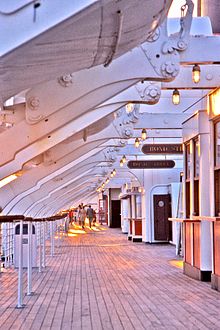
This second plan was based on the conversion of most of its first class and cabin class cabins on Decks A and B into hotel rooms, and the conversion of the main lounges and dining rooms into banquet spaces. On the promenade deck, the starboard promenade has been closed to offer an exclusive restaurant and café called "Lord Nelson & Lady Hamilton's"; decorated thematically in the style of sailing ships from the beginning of the 19th century century. The famous and elegant observation bridge was redecorated as a Wild West-themed bar.
Smaller public areas in first class, such as the reading room, library and music studio, would be stripped of most of their decoration and remodeled for commercial use, allowing the ship's common spaces to expand. Two more tents were set up on the promenade deck, in separate spaces previously dedicated to first-class cabins and crew quarters.
One of the spaces after World War II, the first-class cinema, was eliminated in order to gain space for the kitchen units of the new restaurants on the promenade deck. The first class lounge and smoking room were reconfigured and converted into banquet rooms. The cabin class smoking room was subdivided into a wedding chapel and office space. On the promenade deck, the elegant Verandah Grill restaurant would be removed and converted into a fast food establishment, while a new restaurant would be created just above on the sports deck, in a space previously dedicated to the officers' cabins.
The cabin class lounges were expanded to the sides of the ship and used for banquets. On the R deck, the first class lounge was reconfigured and subdivided into two banquet areas, the Royal Salon and the Windsor Room. The cabin class restaurant was in turn subdivided to be used as a kitchen storage area and a lounge for employees, while the economy class restaurant was initially used for storage and crew space.
Also on the R deck, the first-class Turkish baths complex, the equivalent of a spa in the 1930s it was retired. The cabin class pool was also eliminated and its space was used for offices, while the first class pool was used for hotel guests. Remodeled to meet safety codes and the structural integrity of the area immediately below, the pool is however no longer in use today. No crew cabin has survived intact to this day.
Tourist attraction and floating hotel
On May 8, 1971, the Queen Mary opened its doors to tourists. Initially, only some portions of the ship were open to visitors, as Specialty Restaurants had not yet opened its restaurants and Pacific Southwest Airlines (PSA) had not completed work converting first-class cabins into guest rooms. hotel. As a result, the ship was only open on weekends. On December 11, 1971, the Jacques Cousteau museum opened, with only a quarter of the total exhibits planned. Over the course of the decade, the museum closed due to poor ticket sales and the death of many of the museum's fish. On November 2, 1972, the PSA hotel opened the first 150 rooms for guests. Two years later, with nearly 400 rooms completed, PSA invited the Hyatt hotel complex to take over the hotel. He managed the venue between 1974 and 1980, as the Queen Mary Hyatt Hotel.
By 1980, it was apparent that the existing management system was not working. The ship was losing the city millions each year, as the hotel, restaurants and museum were managed by three different concessionaires, while the City owned the boat and operated the guided tours. It was then decided that an operator with more experience in attractions was needed.
Jack Wrather, a local millionaire, had fallen in love with the ship because he and his wife, actress Bonita Granville, had very good memories of their stay on the ship during numerous voyages. Wrather signed a 66-year lease agreement with the city of Long Beach to operate the ship as a whole. He oversaw the exhibition of the Spruce Goose, through a long-term loan. The immense plane, which had sat in a Long Beach hangar for decades without being on public display, was installed in a large geodesic dome adjacent to the liner in 1983, attracting increasing numbers of tourists.
His company Wrather Port Properties operated the complex from his death in 1984 until 1988, when his properties were purchased by the Walt Disney Company. Wrather had built the Disneyland Hotel in California in 1955, when Walt Disney did not have enough funds to build the hotel complex himself. Disney had been trying to buy the hotel for 30 years. When they were finally successful, they also acquired the Queen Mary. However, it was never exhibited as a Disney property.

During the late 1980s and early 1990s, the Queen Mary faced financial problems. Disney was pinning its hopes on making the attraction another part of Port Disney, a planned resort in the adjacent port. It would include a theme park known as DisneySea, themed around the theme of the world's oceans. The plans ultimately did not go ahead; In 1992, Disney abandoned the transfer of the ship to focus on the construction of what would become Disney California Adventure Park. The DisneySea concept was recycled a decade later in Japan as Tokyo DisneySea, with the recreation of an ocean liner similar in appearance to the Queen Mary, baptized as the SS Columbia, as the fundamental piece of the American Waterfront area.
Following Disney's abandonment, the Queen Mary closed its doors on September 30, 1992. The owners of the Spruce Goose, the Aero Club of Southern California, sold the plane to Evergreen Aviation & Space Museum in Oregon. She left packed on October 2 of that year, leaving the great dome empty. The Queen Mary's tourist attractions remained open for two more months, but on December 31, the ship completely closed its doors to tourists.
On February 5, 1993, RMS Foundation, Inc signed a five-year lease with the city of Long Beach to operate as the operator of the complex. The foundation was led by the president and C.E.O. Joseph F. Prevratil, who had managed the attraction under Wrather. On February 26 of that year, the tourist attraction fully reopened, while the hotel partially reopened on March 5 with 125 rooms and banquet spaces, while the rest of the rooms reopened on April 30. In 1995, the assignment to RMS Foundation was extended for 20 years, while the scope of the assignment was reduced to the operation of the ship. A new company, Queen's Seaport Development, Inc. (QSDI), was established to control the properties adjacent to the ship. In 1998, the City of Long Beach extended QSDI's assignment to age 66.
In 2004, Queen Mary and Stargazer Productions added a space called Tibbies Great American Cabaret on the site previously occupied by the liner bank and radio telegraphy room. The space was transformed into a complete theater, with stage, lights, sound and back room.

In 2005, QSDI sought court protection due to a credit dispute with the city. In 2006, the court declared bankruptcy and requested the presentation of offers interested in resuming the assignment made to QSDI. The minimum entry bid was $41 million. The operation of the ship, carried out by the RMS Foundation, was meanwhile unaffected by the bankruptcy situation. In the summer of 2007, the Queen Mary lease was sold to a group called "Save the Queen" ("Save the Queen") managed by Hostmark Hospitality Group.
This group planned to develop the area adjacent to the Queen Mary, and update, renovate and restore the ship. During his tenure, the rooms were updated with iPod stations and flat-screen televisions, and the ship's three smokestacks and the paint on the hull above sea level were repainted. The port side promenade deck planking was restored and finished. Many lifeboats were repainted and patched, and the ship's galleys were renovated with new equipment.
In late September 2009, management of the Queen Mary was resumed by Delaware North Companies, which planned to continue the restoration and renovation of the ship and its properties. They were determined to revitalize and expand the ship as a tourist attraction. But in April 2011, the city of Long Beach was informed that Delaware North would not ultimately take over management. Garrison Investment Group then stated that the decision was based solely on business. Delaware North still operates the Soviet submarine Scorpion, which has been a tourist attraction located right next to the Queen Mary since 1998.
A new company, Evolution Hospitality, LLC. assumed operational management of the Queen Mary on September 23, 2011, while Garrison Investments leased the ship.
In 2016, Urban Commons, a property management company, took over the Queen Mary. They revealed plans to extensively renovate the liner over the next year, as well as to redevelop the adjacent parking and hotel acreage, restaurants, amphitheater, jogging and bicycle paths, and possibly a large Ferris wheel, all for a cost of up to 250 million dollars.
Reunion between the Cunard Queens

On February 23, 2006, Cunard Line's flagship, RMS Queen Mary 2, remained alongside her predecessor during a visit to the port of Los Angeles during a cruise to Mexico.
The Queen Mary originally had three whistles, and currently retains only one, with which the ship was able to greet its successor, while the Queen Mary 2 responded by blowing its two new whistles, in combination with an original one of the Queen Mary (gifted by the city of Long Beach), which operated at the 55 Hz frequency, chosen because it was low enough that the extremely loud sound would not be harmful to human ears.
However, modern international regulations specify that the frequency of whistles should be in the range of 70–200 Hz for vessels with a wingspan greater than 200 meters. Traditionally, the lower the frequency, the larger the vessel..
Queen Mary 2, 345 meters long, was assigned the lowest possible frequency, along with the Queen Mary's original 55 Hz whistle, which can be heard more than 10 miles away.
In March 2011, the Queen Mary was visited by the MS Queen Victoria, whom she was able to greet again with her only active whistle, while a fireworks display took place. Two years later, March 12, 2013, the former liner was also able to greet Cunard's new cruise ship, the MS Queen Elizabeth, during a similar ceremony.
Radiotelegraphy room

The Queen Mary's original radiotelegraphy room was removed when the ship was in Long Beach. In its place, an amateur radio room was set up, one deck above where the original was located, also using some of the original equipment as a display. The amateur radio, under the name W6RO ("Whiskey Six Romeo Oscar"), is used by volunteers from a nearby amateur radio club. They operate the radio set for much of the day, while the ship remains open to the public, and the radios can also be used by other radio amateurs.
In honor of the more than 40 years of dedication of station W6RO and the Queen Mary, in November 2007 the radio room was renamed the Nate Brightman Radio Room. This fact was announced on October 28, 2007 by Joseph Prevratil, former president and CEO of Queen Mary, at Brightman's 90th birthday party.
The myth of the “haunted ship”
After the Queen Mary was permanently moored in California, rumors began that the ship was haunted. Since the 1980s, this supposed haunting has been promoted in the ship's advertising campaigns, including several attractions and tours introducing the theme to visitors. The ship was in fact classified as 'one of the 10 places most haunted in America" by Time magazine in 2008.
Specifically, it is alleged that cabin B-340 (formerly cabin B-326, prior to post-World War II remodeling) is haunted by the spirit of a person who was murdered there. Some people have reported hearing sounds of children playing in the ship's nursery. Other alleged ghosts include a sailor who was accidentally killed in the engine room, the crew of HMS Curacoa, who died when the Queen Mary collided with the ship, and a "lady in white" unidentified. At least one book has been published on the matter, including these cases.
At least 49 passengers and crew are known to have died while the Queen Mary was in service as an ocean liner. Although some cases are presented as the ghosts of drowned victims, the ship's log does not include any cases of passengers who drowned during a voyage. Approximately 75% of the deaths correspond to members of the crew, with the rest being passengers.. The exact number of people, soldiers or prisoners of war who died on the Queen Mary during its use as a troop transport in World War II is unknown, however.
Skeptical researcher John Champion wrote in the Skeptical Inquirer magazine that he understands why people persist in believing that the Queen Mary is haunted, even though all the evidence they can provide is anecdotes, feelings strange and shadows. Tourists who sign up for the "haunted tour" are offered access to more of the ship that is not usually shown, while conventional tours that simply describe the ship's history are more limited. Champion believes the owners are doing no real service to the ship's real history, nor to the people who should be honored by "remembering who they really were and what they did."
Understand that people claim to have seen or heard strange things, since the ship is still creaking, and people's imaginations can take conventional events like these so that they believe they have experienced or heard all kinds of things, attributing it to something paranormal because they are predisposed to it. "Ghost stories are fine," Champion concludes, "when they are presented as such. The confusion of science and history with fiction... distances us from the ability to truly enjoy and explore our own recent history.
Queen Mary in the cinema
In the 1970s, the Queen Mary played the role of the SS Poseidon in director Irwin Allen's film The Poseidon Adventure, which won an Oscar for visual effects.
The Queen Mary also appeared in the 2001 film Pearl Harbor, where Ben Affleck and Kate Beckinsale appear in a romance scene, and in the film Titanic II in some of the scenes where the ship is moored in the port.
Profile of the Queen Mary

Contenido relacionado
Annex: Annual table of the fourteenth century
Aquatint engraving
Computational physics

